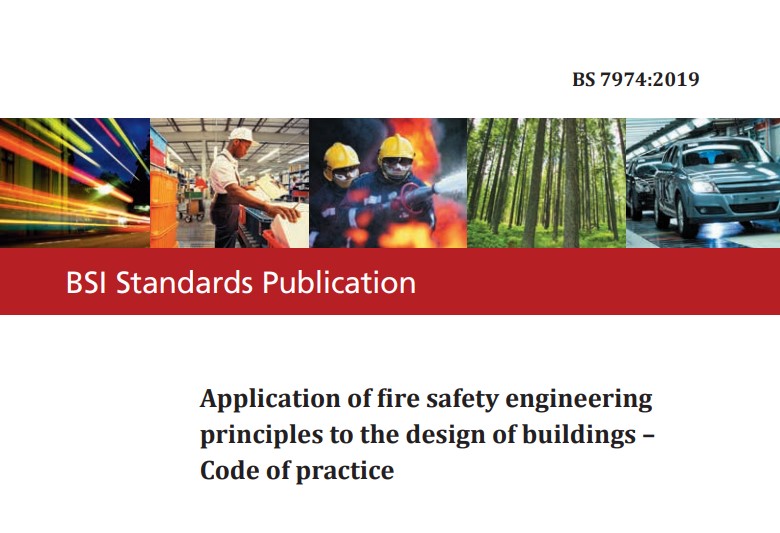BS 7974

|
Contents |
[edit] Introduction
The British Standards Institution (BSI) is the UK National Standards Body (NSB). It publishes standards and provides a range of books, self-assessment tools, conferences and training services. It also represents UK economic and social interests in European and international standards organisations.
BS 7974 Application of fire safety engineering principles to the design of buildings. Code of practice is aimed at fire safety engineers (FSE) and practitioners, and is also intended for:
- Members of the fire and rescue service.
- Structural engineers.
- Architects.
- Government agencies.
- Regulators
- Related industries such as insurers and systems engineers.
BS 7974 was originally released in 2001, with additional updates in 2002, 2003 and 2012. In 2016, however, a 2019 update was the first complete revision since the initial publication of the standard.
[edit] Published documents
Due to the number of published documents (PDs) associated with BS 7974, the complete standard is available as a suite of documents, which includes:
- PD 7974-1 Initiation and development of fire within the enclosure of origin.
- PD 7974-2 Spread of smoke and toxic gases within and beyond the enclosure of origin.
- PD 7974-3 Structural response and fire spread beyond the enclosure of origin.
- PD 7974-4 Detection of fire and activation of fire protection systems. NOTE: This document is no longer maintained since it has been incorporated into other documents, but it is referred to as part of the PD 7974 series for the sake of completeness.
- PD 7974-5 Fire and rescue service intervention.
- PD 7974-6 Occupant evacuation, behaviour and condition.
- PD 7974-7 Probabilistic risk assessment.
The practices included within the standard are applicable to all types of new construction and existing buildings. It is based on an approach to fire safety that focusses on the protection of people and property while showing sensitivity to the environment.
[edit] Qualitative design review
This analytical process is based on the concept of qualitative design review (QDR), which is a technique that allows fire safety engineers to consider the possible ways a fire hazard might arise and establish a range of strategies to maintain the risk at an acceptable level.
The process is broken down into three stages:
- Initial review. Objectives are defined, criteria are established and solutions are proposed.
- Analysis: Evaluations are made of solutions identified in the initial review.
- Assessment: The results of the analysis are measured against the criteria in the initial review.
[edit] Related articles on Designing Buildings Wiki
- Addressing building failures: Grenfell Tower and Edinburgh schools.
- British Standards Institution BSI.
- BS 9999: Code of practice for fire safety in the design, management and use of buildings.
- BS EN 13501-1
- Fire engineered building.
- Fire in buildings.
- Overview of automatic sprinkler system design and operation
- Qualitative design review.
- The role of codes, standards and approvals in delivering fire safety.
[edit] External resources
- BSI, BS 7974:2019.
Featured articles and news
Delivering for tenants; National Retrofit Hub
New report offers recommendations to strengthen energy efficiency standards to protect private renters.
Government consultations for the summer of 2025
A year of Labour, past and present consultations on the environment, the built environment, training and tax.
CMA competitiveness probe of major housing developers
100 million affordable housing contributions committed with further consultation published.
Homes England supports Greencore Homes
42 new build affordable sustainable homes in Oxfordshire.
Zero carbon social housing: unlocking brownfield potential
Seven ZEDpod strategies for brownfield housing success.
CIOB report; a blueprint for SDGs and the built environment
Pairing the Sustainable Development Goals with projects.
Types, tests, standards and fires relating to external cladding
Brief descriptions with an extensive list of fires for review.
Latest Build UK Building Safety Regime explainer published
Key elements in one short, now updated document.
UKGBC launch the UK Climate Resilience Roadmap
First guidance of its kind on direct climate impacts for the built environment and how it can adapt.
CLC Health, Safety and Wellbeing Strategy 2025
Launched by the Minister for Industry to look at fatalities on site, improving mental health and other issues.
One of the most impressive Victorian architects. Book review.
Common Assessment Standard now with building safety
New CAS update now includes mandatory building safety questions.
RTPI leader to become new CIOB Chief Executive Officer
Dr Victoria Hills MRTPI, FICE to take over after Caroline Gumble’s departure.
Social and affordable housing, a long term plan for delivery
The “Delivering a Decade of Renewal for Social and Affordable Housing” strategy sets out future path.
A change to adoptive architecture
Effects of global weather warming on architectural detailing, material choice and human interaction.
The proposed publicly owned and backed subsidiary of Homes England, to facilitate new homes.
How big is the problem and what can we do to mitigate the effects?
Overheating guidance and tools for building designers
A number of cool guides to help with the heat.
The UK's Modern Industrial Strategy: A 10 year plan
Previous consultation criticism, current key elements and general support with some persisting reservations.
Building Safety Regulator reforms
New roles, new staff and a new fast track service pave the way for a single construction regulator.

























